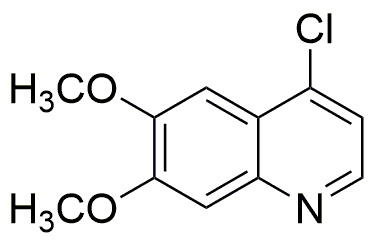4-Chloro-6,7-dimethoxyquinoline is widely utilized in research focused on:
- Pharmaceutical Development: This compound serves as a key intermediate in the synthesis of various pharmaceuticals, particularly those targeting infectious diseases.
- Antimicrobial Research: It has demonstrated potential as an antimicrobial agent, making it valuable in developing new treatments for bacterial infections.
- Biological Studies: Researchers use it to study quinoline derivatives' biological activity, helping to understand their mechanisms and effects on living organisms.
- Material Science: The compound is explored for its properties in developing advanced materials, including coatings and polymers, due to its unique chemical structure.
- Analytical Chemistry: It serves as a standard in analytical methods for detecting and quantifying related compounds in various samples, ensuring accuracy in research and quality control.
General Information
Properties
Safety and Regulations
Applications
4-Chloro-6,7-dimethoxyquinoline is widely utilized in research focused on:
- Pharmaceutical Development: This compound serves as a key intermediate in the synthesis of various pharmaceuticals, particularly those targeting infectious diseases.
- Antimicrobial Research: It has demonstrated potential as an antimicrobial agent, making it valuable in developing new treatments for bacterial infections.
- Biological Studies: Researchers use it to study quinoline derivatives' biological activity, helping to understand their mechanisms and effects on living organisms.
- Material Science: The compound is explored for its properties in developing advanced materials, including coatings and polymers, due to its unique chemical structure.
- Analytical Chemistry: It serves as a standard in analytical methods for detecting and quantifying related compounds in various samples, ensuring accuracy in research and quality control.
Documents
Safety Data Sheets (SDS)
The SDS provides comprehensive safety information on handling, storage, and disposal of the product.
Product Specification (PS)
The PS provides a comprehensive breakdown of the product’s properties, including chemical composition, physical state, purity, and storage requirements. It also details acceptable quality ranges and the product's intended applications.
Certificates of Analysis (COA)
Search for Certificates of Analysis (COA) by entering the products Lot Number. Lot and Batch Numbers can be found on a product’s label following the words ‘Lot’ or ‘Batch’.
Numéro de catalogue
Numéro de lot/série
Certificates Of Origin (COO)
This COO confirms the country where the product was manufactured, and also details the materials and components used in it and whether it is derived from natural, synthetic, or other specific sources. This certificate may be required for customs, trade, and regulatory compliance.
Numéro de catalogue
Numéro de lot/série
Safety Data Sheets (SDS)
The SDS provides comprehensive safety information on handling, storage, and disposal of the product.
DownloadProduct Specification (PS)
The PS provides a comprehensive breakdown of the product’s properties, including chemical composition, physical state, purity, and storage requirements. It also details acceptable quality ranges and the product's intended applications.
DownloadCertificates of Analysis (COA)
Search for Certificates of Analysis (COA) by entering the products Lot Number. Lot and Batch Numbers can be found on a product’s label following the words ‘Lot’ or ‘Batch’.
Numéro de catalogue
Numéro de lot/série
Certificates Of Origin (COO)
This COO confirms the country where the product was manufactured, and also details the materials and components used in it and whether it is derived from natural, synthetic, or other specific sources. This certificate may be required for customs, trade, and regulatory compliance.


